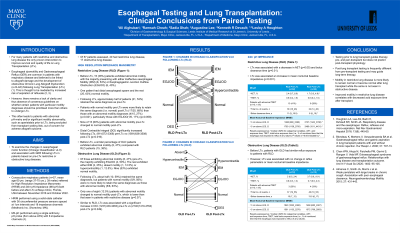Sunday Poster Session
Category: Esophagus
P0432 - Esophageal Testing and Lung Transplantation: Clinical Conclusions From Paired Motility and Reflux Testing
Sunday, October 22, 2023
3:30 PM - 7:00 PM PT
Location: Exhibit Hall

Has Audio
- KD
Kenneth R. DeVault, MD
Mayo Clinic
Jacksonville, FL
Presenting Author(s)
Ali Alghubari, MBBCh1, Ramsah Cheah, MA1, Sadia Shah, MD2, Augustine Lee, MD2, Lesley A. Houghton, PhD, FACG3, Kenneth R. DeVault, MD2
1University of Leeds, Leeds, England, United Kingdom; 2Mayo Clinic, Jacksonville, FL; 3University of Leeds School of Medicine, Leeds, England, United Kingdom
Introduction: Esophageal dysmotility and gastroesophageal reflux (GER) are common in respiratory disease and following lung transplant (LTx), and predict worse pulmonary function and disease progression. Timing and significance of testing for esophageal disease in these patients remain unclear. Aim: To examine the changes in esophageal motor function (Chicago Classification v4.0) following LTx and association with GER in patients with restrictive (RLD) or obstructive (OLD) lung disease.
Methods: High resolution impedance esophageal manometry (HRIM) and 24hr impedance-pH (MII-pH) was performed in 57 respiratory patients (40 restrictive, 17 obstructive) before and after LTx (mean age 60 yrs (range 33-75 yrs), 39 males) between November 2016 and October 2022.
Results: RLD: Before LTx, 15(38%) exhibited abnormal motility; the majority ineffective esophageal motility (IEM)(8,53%) or esophagogastric junction outflow obstruction (EGJOO)(6,40%). 1 had distal esophageal spasm and the rest were (25,63%) normal. Following LTx, 21(53%) retained the same diagnosis as pre-LTx. Patients with normal motility pre-LTx were more likely to retain the same diagnosis post-LTx (17/25, 68%) than those with abnormal motility (4/15,27%)(p=0.021), particularly EGJOO(1/6, 17%)(p=0.059). 9 of 15 (60%) with abnormal motility pre-LTx changed to normal post-LTx.
OLD: Before LTx, 8(47%) exhibited abnormal motility, with the majority EGJOO (4,50%). The rest had IEM (2,25%), absent motility (1,12.5%) or hypercontractility (1,12.5%). 9 (53%) exhibited normal motility. Following LTx 10 (59%) retained the same diagnoses, but those with normal motility (5/9,56%) were no more likely to retain the same diagnoses as those with abnormal motility (5/8,63%). 1 of 8 (12.5%) with abnormal motility changed to normal post-LTx, which is lower than seen in RLD(p=0.07). pH findings revealed that although acid exposure time (AET) was similar pre-LTx (RLD 2.4(0.7-7.0) v OLD 2.0(0.5-3.4); p=0.53), there was a decrease in AET in RLD (1.7(0.3-3.5);p=0.05) but no change in OLD (3.7(0.6-10.1);p=0.31) post-LTx.
Discussion: 1.Testing prior to LTx guides therapy pre-and peri-LTx but does not predict post-LTx physiology.
2. Post-LTx testing is frequently different from pre-LTx testing and may guide long-term therapy.
3. Motility in RLD is more likely to remain normal or change to normal post-LTx than in OLD, and appears to predict improved AET.
Disclosures:
Ali Alghubari, MBBCh1, Ramsah Cheah, MA1, Sadia Shah, MD2, Augustine Lee, MD2, Lesley A. Houghton, PhD, FACG3, Kenneth R. DeVault, MD2. P0432 - Esophageal Testing and Lung Transplantation: Clinical Conclusions From Paired Motility and Reflux Testing, ACG 2023 Annual Scientific Meeting Abstracts. Vancouver, BC, Canada: American College of Gastroenterology.
1University of Leeds, Leeds, England, United Kingdom; 2Mayo Clinic, Jacksonville, FL; 3University of Leeds School of Medicine, Leeds, England, United Kingdom
Introduction: Esophageal dysmotility and gastroesophageal reflux (GER) are common in respiratory disease and following lung transplant (LTx), and predict worse pulmonary function and disease progression. Timing and significance of testing for esophageal disease in these patients remain unclear. Aim: To examine the changes in esophageal motor function (Chicago Classification v4.0) following LTx and association with GER in patients with restrictive (RLD) or obstructive (OLD) lung disease.
Methods: High resolution impedance esophageal manometry (HRIM) and 24hr impedance-pH (MII-pH) was performed in 57 respiratory patients (40 restrictive, 17 obstructive) before and after LTx (mean age 60 yrs (range 33-75 yrs), 39 males) between November 2016 and October 2022.
Results: RLD: Before LTx, 15(38%) exhibited abnormal motility; the majority ineffective esophageal motility (IEM)(8,53%) or esophagogastric junction outflow obstruction (EGJOO)(6,40%). 1 had distal esophageal spasm and the rest were (25,63%) normal. Following LTx, 21(53%) retained the same diagnosis as pre-LTx. Patients with normal motility pre-LTx were more likely to retain the same diagnosis post-LTx (17/25, 68%) than those with abnormal motility (4/15,27%)(p=0.021), particularly EGJOO(1/6, 17%)(p=0.059). 9 of 15 (60%) with abnormal motility pre-LTx changed to normal post-LTx.
OLD: Before LTx, 8(47%) exhibited abnormal motility, with the majority EGJOO (4,50%). The rest had IEM (2,25%), absent motility (1,12.5%) or hypercontractility (1,12.5%). 9 (53%) exhibited normal motility. Following LTx 10 (59%) retained the same diagnoses, but those with normal motility (5/9,56%) were no more likely to retain the same diagnoses as those with abnormal motility (5/8,63%). 1 of 8 (12.5%) with abnormal motility changed to normal post-LTx, which is lower than seen in RLD(p=0.07). pH findings revealed that although acid exposure time (AET) was similar pre-LTx (RLD 2.4(0.7-7.0) v OLD 2.0(0.5-3.4); p=0.53), there was a decrease in AET in RLD (1.7(0.3-3.5);p=0.05) but no change in OLD (3.7(0.6-10.1);p=0.31) post-LTx.
Discussion: 1.Testing prior to LTx guides therapy pre-and peri-LTx but does not predict post-LTx physiology.
2. Post-LTx testing is frequently different from pre-LTx testing and may guide long-term therapy.
3. Motility in RLD is more likely to remain normal or change to normal post-LTx than in OLD, and appears to predict improved AET.
Disclosures:
Ali Alghubari indicated no relevant financial relationships.
Ramsah Cheah indicated no relevant financial relationships.
Sadia Shah indicated no relevant financial relationships.
Augustine Lee indicated no relevant financial relationships.
Lesley A. Houghton: GSK – Advisory Committee/Board Member. Ironwood Pharmaceuticals Inc. – Advisory Committee/Board Member. Pfizer, USA – Consultant.
Kenneth DeVault indicated no relevant financial relationships.
Ali Alghubari, MBBCh1, Ramsah Cheah, MA1, Sadia Shah, MD2, Augustine Lee, MD2, Lesley A. Houghton, PhD, FACG3, Kenneth R. DeVault, MD2. P0432 - Esophageal Testing and Lung Transplantation: Clinical Conclusions From Paired Motility and Reflux Testing, ACG 2023 Annual Scientific Meeting Abstracts. Vancouver, BC, Canada: American College of Gastroenterology.
